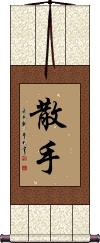Many custom options...
And formats...

Not what you want?
Try other similar-meaning words, fewer words, or just one word.
Feel free to email me with your request. If it's easy, I'll translate it for free and add it to this database of calligraphy for you.
San Soo San Shou in Chinese / Japanese...
Buy a San Soo San Shou calligraphy wall scroll here!
Personalize your custom “San Soo San Shou” project by clicking the button next to your favorite “San Soo San Shou” title below...
Kung Fu San Soo / San Shou
功夫散手 is a martial arts title.
Oddly, there are multiple ways two spell/romanize this in English, but in Chinese, it's written exactly the same.
Technically, the Mandarin romanizes as “gong fu san shou,” for which you'll sometimes see it written “kung fu san shou” (k'ung is an old romanization for a word that sounds like gong with a vowel sound like “oh”).
There is another martial arts style that spells this “Kung Fu San Soo.” I guess this was supposed to approximate Cantonese pronunciation for which the scholarly romanization is generally agreed to be “gung fu saan sau.”
San Soo / San Shou
散手 is a martial arts title sometimes spelled in English as “San Soo” or “San Shou.”
The Mandarin version romanizes as “San Shou.” Mandarin Chinese is the most common dialect in China (literally 99% of Chinese people speak standard Mandarin along with their local dialect).
There is another martial arts style that spells this “San Soo.” I guess this was supposed to approximate Cantonese pronunciation for which the scholarly romanization is generally agreed to be “Saan Sau.”
The following table may be helpful for those studying Chinese or Japanese...
| Title | Characters | Romaji (Romanized Japanese) | Various forms of Romanized Chinese | |
| Kung Fu San Soo San Shou | 功夫散手 | gōng fu sǎn shǒu gong1 fu san3 shou3 gong fu san shou gongfusanshou | kung fu san shou kungfusanshou |
|
| San Soo San Shou | 散手 | sǎn shǒu / san3 shou3 / san shou / sanshou | ||
Successful Chinese Character and Japanese Kanji calligraphy searches within the last few hours...





